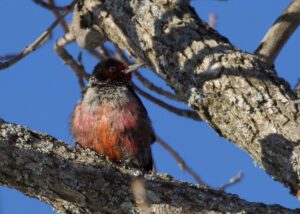by Tom Sasvari
BILLINGS TOWNSHIP—It appears Meriwether has made himself at home on the property of Phyllis and Bob Cacciotti of Billings Township. As was reported in the January 25, edition of The Expositor, Meriwether is a Lewis’s woodpecker, a bird not normally found in this part of the world. The rare sighting of this bird on Manitoulin Island has caused quite a stir in the bird sighting world.
“I thought you might be interested to know that the Lewis’s woodpecker, aka Meriwether, is still with us, since January 9 when I first saw him,” said Ms. Cacciotti in a March 29 email to The Expositor. “We have now had four viewings through the Rare Bird Ambassador Program with the Ontario Field Ornithologist (OFO) and, all in all, 264 people from all parts of Ontario have seen him. Many people have contacted me directly to see him and that has worked out fine. Everyone who has come has been so respectful!”
A fifth viewing was scheduled for Saturday, April 1, also through OFO.
“It appears Meriwether has found what he wants here,” said Ms. Cacciotti. “He has been here two and a half months every day. I feed him every day, and I know where he sleeps.”
“He is so territorial and has been right from the beginning,” Ms. Cacciotti said. Meriwether has chased away a pileated woodpecker, a squirrel, two crows and mourning doves. “He is pretty non-spooked.”
“He might cross breed with another woodpecker, or he might end up leaving some day,” she added.
The birding community has been amazing, added Ms. Cacciotti. “There has been a huge influx to the Island, many people have never been here before, and many stay overnight on the Island. We have had birders that will drive halfway across the province just to see him. It has been good for tourism.”
“A lot of the birders have never seen this type of bird before,” Ms. Cacciotti said. “My question is, how did Meriwether find us on Manitoulin Island?”
The bird’s normal range is the west coast of the United States and British Columbia, she said. “They don’t generally venture much further east than western Alberta and even then, it’s during the summer season. They are mostly found in the west and into the interior a bit. I’m told there have only been two sightings in Ontario in 20 years.”
Bruce Kirkland an ambassador with OFO rare bird ambassador program said previously the bird is probably from the northern population of Lewis’s woodpeckers, likely British Columbia or Washington. The southern population in the western US are short term migrants. It’s the ones in the north that migrate further distances.
Ms. Cacciotti noted that Meriwether has had artists use him as a subject to paint, draw and be featured on a t-shirt. Paul Riss, a well-known birder on the Island has had a t-shirt made with Meriwether’s picture and Billings on it, and Kagawong artist Marc Denomme has painted the bird.
“He has affected a lot of people,” said Ms. Cacciotti.

“We have raised over $2,000, which is being donated back to the Manitoulin Nature Club,” she added “Not only did the birders come, they donated generously and apparently it’s normal practice to have a donation jar at viewings.”
“It’s going to be tough if he leaves,” said Ms. Cacciotti. “He has become pretty special.”
Anyone who wants to see Meriwether can reach out to the Manitoulin Nature Club (manitoulinnatureclub@gmail.com).
Meriwether Lewis was the leader of the Lewis and Clark exploratory expedition of 1803 to 1806 across the American continent and in May 1806, the party collected several “black woodpeckers” near Kamiah, Idaho. These birds were later examined by Alexander Wilson, who gave the bird the common name of Lewis’s woodpecker or Melanerpes lewis. This bird is a western species, whose habit ranges mainly from Colorado west to the Pacifica, and from southern British Columbia south to northwestern Mexico. During her research Ms. Cacciotti learned the British Columbia population of Lewis’s woodpeckers is considered to be imperiled, as the breeding population within Canada is believed to be only around 371 pairs.
“Its population is small, with fewer than 1,000 individuals, and there is evidence of ongoing declines in parts of its Canadian range where it has been monitored over time,” Ms. Cacciotti said. “The global population (Canada and the US) is also showing significant declines. Threats include habitat loss and degradation from increasing urban and agriculture development and fire suppression. Recent surveys have shown the species to be far less numerous than previously believed.’





